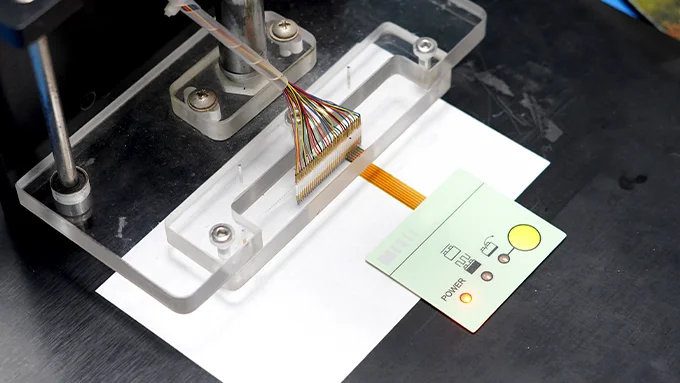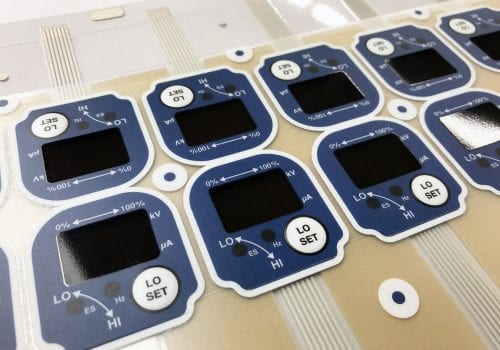The Production Process Behind Membrane Switch: What You Need to Know
The manufacturing procedure behind membrane switches over combines cautious layout, product option, and quality assurance. It starts with recognizing the details of membrane layer switch design and progresses with numerous stages, consisting of product choices and printing techniques. Each phase plays a necessary function in ensuring performance and resilience. The intricacies of layer building and construction and the rigorous screening criteria may expose insights that are not promptly noticeable. What lies beyond these foundational aspects?
Recognizing Membrane Switch Over Layout
Although membrane switches might appear straightforward initially glance, their design involves detailed factors to consider that assure capability and longevity. The style process begins with an extensive understanding of customer requirements, consisting of the interface's designated application and ecological aspects. Comfort designs is a crucial element, as the design needs to help with ease of usage while guaranteeing that tactile comments satisfies individual expectations.Moreover, the layering of parts, such as visuals overlays, sticky layers, and conductive traces, must be precisely engineered. membrane switch. This layered configuration not just affects the switch's responsiveness yet also impacts its durability. Focus is offered to the sealing strategies employed to protect versus moisture and dirt, which can compromise performance. In addition, design factors to consider prolong to looks, where color pattern and visual clarity improve user experience. Eventually, the layout of membrane layer changes equilibriums capability, customer experience, and longevity, ensuring that they fulfill the needs of numerous applications efficiently
Materials Made Use Of in Membrane Change Production
When picking products for membrane layer button manufacturing, it is important to consider both efficiency and durability. The main products include polyester and polycarbonate films, which supply flexibility and strength. These movies are commonly covered with glue to assure proper bonding to substrates. Conductive inks, usually made up of silver or carbon, are critical for producing electric connections within the switch, permitting trusted operation.Additionally, a safety layer, such as a difficult coat, is often related to improve scratch resistance and long life. The selection of backing material, such as acrylic or foam, can considerably influence the switch's responsive feel and general user experience. Moreover, different ecological factors, including temperature level and moisture, must guide product option to guarantee peak performance in details applications. Inevitably, the ideal mix of products adds to the membrane layer button's performance and life expectancy, making notified choices vital for manufacturers.
The Printing Process: Creating Video and Text
The printing process in membrane button production plays a substantial function in creating top quality graphics and text. Numerous visuals design techniques are used to guarantee aesthetic appeal and performance, while careful ink selection methods are important for sturdiness and efficiency. Understanding these elements is fundamental for attaining finest results in membrane switch design.
Graphic Style Techniques
Graphic design methods play a necessary duty in the printing procedure of membrane layer buttons, as they define how graphics and message will inevitably show up on the last product. Efficient graphic style includes the critical usage of typefaces, shades, and designs to enhance readability and visual allure. Developers commonly make use of vector graphics for scalability, making certain that images continue to be sharp at various dimensions. Furthermore, focus to comparison and alignment is important, as it influences user communication and visual high quality. The incorporation of branding components, such as logos, must be taken care of with like maintain brand name honesty. On the whole, thoughtful visuals layout strategies contribute significantly to the capability and beauty of membrane switches, impacting customer experience and item efficiency.
Ink Selection Techniques
Picking the suitable ink is vital for attaining the wanted aesthetic high quality and longevity in membrane layer switch production. Various ink kinds are utilized, including solvent-based, water-based, and UV-curable inks. Each type provides unique attributes, such as flexibility, attachment, and resistance to ecological variables. Solvent-based inks are usually preferred for their sturdiness and lively shades, while water-based inks are extra environmentally pleasant but might have constraints in attachment. UV-curable inks provide fast treating and robust efficiency. In addition, shade matching methods guarantee that the selected inks straighten with style specs. Inevitably, the selection of ink need to consider variables such as application method, substratum compatibility, and end-use needs to accomplish remarkable cause membrane switch graphics and text.
Layer Construction and Setting Up

Material Option Process
A mindful selection of materials is essential in the production procedure of membrane buttons, as it directly affects functionality and durability. The key materials used consist of polyester, polycarbonate, and various conductive inks. Polyester is usually favored for its superb resistance to chemicals and abrasion, making it suitable for severe settings. Polycarbonate, on the other hand, provides superior quality and influence resistance, which is useful for applications requiring visibility and robustness. Conductive inks, generally made up of silver or carbon, are essential for developing dependable electric pathways. In addition, the choice of glue products affects the overall integrity of the button - membrane switch. Reviewing elements such as environmental direct exposure, tactile comments, and visual requirements overviews producers in choosing the very best materials for their particular applications
Layer Adhesion Methods
Adhering layers in membrane button building and construction is a crucial procedure that assures performance and long life. Different attachment strategies are employed to secure suitable bonding between layers, which commonly include making use of adhesives, heat, and stress. Pressure-sensitive adhesives (PSAs) are generally made use of for their simplicity over here of application and instant bonding capacities. Furthermore, thermal bonding methods can be used, where warm is used to trigger sticky properties, safeguarding a strong bond. The selection of attachment method mostly depends upon the products included and the details application demands of the membrane layer button. Appropriate placement and consistent application of adhesives are important to protect against issues, safeguarding the button runs effectively throughout its desired lifespan.
Quality Assurance Actions
Assuring quality assurance during the layer construction and setting up of membrane buttons is vital for maintaining performance and reliability. This procedure usually involves numerous crucial steps, consisting of thorough evaluations at each phase of manufacturing. Suppliers make use of sophisticated screening methods, such as peel tests and attachment evaluations, to verify the stability of layer bonds. Furthermore, visual assessments are carried out to identify any kind of flaws in printing or material inconsistencies. Environmental conditions, such as temperature level and humidity, are meticulously kept an eye on to ensure suitable healing and bond. Moreover, regular calibration of tools assists keep precise production standards. By executing these quality assurance procedures, makers can considerably minimize the threat of product failure, guaranteeing that the final membrane layer changes fulfill the required specs and customer expectations.
Testing and High Quality Control Procedures

Technologies in Membrane Change Technology
As innovations in innovation remain to advance, membrane layer switches are taking advantage of ingenious growths that enhance their capability and user experience. One noteworthy innovation is the assimilation of capacitive touch modern technology, which enables for more receptive and intuitive user interfaces. This shift not just enhances appearances but also lowers mechanical damage, prolonging the life expectancy of the switches.Additionally, innovations in graphic overlay products have actually resulted in improved longevity and resistance to ecological variables such as wetness and UV light. These products currently use boosted clearness and brightness, further boosting the visual appeal.Furthermore, the consolidation of wise modern technology is changing membrane layer switches into interactive control board, enabling connection with IoT devices. This connection promotes a seamless user experience, leading the way for applications in various markets, from medical care to customer electronic devices. Collectively, these developments setting membrane layer changes as essential parts in contemporary device layout.
Regularly Asked Concerns
How much time Does the Membrane Layer Switch Manufacturing Refine Take?
The duration of the membrane switch manufacturing process can vary considerably. Elements such as intricacy, products used, and manufacturing quantity impact timelines, with common production varying from a few days to several weeks for completion.
What Are the Usual Applications for Membrane Layer Switches?
Membrane layer switches are typically made use of in different sectors, consisting of automobile controls, house devices, medical tools, and customer electronic devices (membrane switch). Their adaptability and longevity make them perfect for applications needing straightforward user interfaces and trustworthy performance in varied environments
Can Membrane Layer Switches Over Be Personalized for Specific Requirements?
What Is the Life expectancy of a Common Membrane Layer Switch?
The life expectancy of a normal membrane switch differs, however typically, it ranges from 1 to 5 million cycles. Variables such as use, setting, and worldly quality greatly affect resilience and total efficiency with time.

Are Membrane Changes Eco-friendly?
The environmental friendliness of membrane layer changes varies. Some materials made use of might not from this source be recyclable, while others can be green. The total effect depends on manufacturing products and methods, necessitating careful factor to consider throughout selection and disposal. The production process behind membrane changes combines mindful style, product selection, and high quality control. It begins with recognizing the details of membrane layer switch layout and proceeds through various phases, consisting of product options and printing techniques. When picking materials for membrane switch manufacturing, it is important to ponder both efficiency and longevity. A careful selection of products is crucial in the production procedure of membrane layer switches, as it straight affects capability and longevity. The choice of bond method mainly depends on the materials entailed and the specific application requirements of the membrane switch.